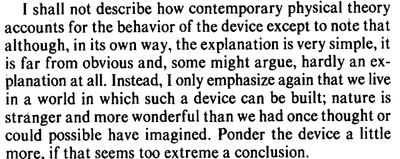Bringing home the atomic world: Quantum mysteries for anybody. N. D. Mermin in Am. J. Phys. 49:940 (1981). What the paper says!?

Bringing home the atomic world: Quantum mysteries for anybody. N. D. Mermin in Am. J. Phys. 49:940 (1981).
Mermin aims here to do what the title promises: allow anybody to understand what's weird about quantum mechanics.
This particular text holds a claim to fame for having been described by Feynman (for whom Mermin has unbounded admiration) as ««one of the most beautiful papers in physics»» (to be found for instance in Perfectly Reasonable Deviations from the Beaten Track according to the Wikipedia).
This is a shorter (first) version of Ref. [1], which is probably better known. In both texts,
The argument is addressed to readers who know nothing of the quantum theory or, for that matter, of classical physics either.
Mermin's aim
is to bring such readers directly up against one of the most strikingly odd ways the world can behave. Those who follow the argument should be as able as practicing physicists to ponder the metaphysical implications of the Einstein-Podolsky-Rosen conundrum.
The text is indeed accessible in this sense. This is thus a great opportunity for anyone interested in contemplating the deepest issue of Modern Physics to challenge their intuition and sanity. There the Author shows, compellingly and with clear arguments, that a hypothetical apparatus (two detectors and a source), as shown below, behaves in a way which one can not understand:

The behavior is that when switches (1, 2 or 3) on each detector are the same, they both flash the same color, while if they are not the same, then it must be that they flash at least 1/3 of the time different colors, as Mermin convinces you by working out all the possibilities from the only way this can work, namely, with the particles triggering the colors to carry the information in the first place. Said again, there's no way to attribute this information without at least 1/3 of different colors for mismatched settings, if they always match when settings are the same. Mermin challenges to try to find one. That no local objective reality can be encoded is stated as "it cannot be proved":

which is surprising as this appears to be Bell's theorem.
Anyway, the point is that one can build a quantum mechanical version that does match all the time for the same settings, but only 1/4 of the time do they produce different colors. He concludes:

He has another conclusion in the appendix, where he brings the more advanced readers "into the black box":

This text is just before Aspect et al.'s experimental implementation[2] (Mermin's text is published on January 5 while Aspect's work is received 30 March, and published 17 of August). So the setup is described as not yet existing but with ««no reason in principle why it could not be»» (indeed Aspect was doing precisely that).
Interestingly, we also learn (in Note 5) that the scheme is inspired from Ref. [3] (did Feynman read d'Espagnat?).
References
- ↑ Is the Moon There When Nobody Looks? Reality and the Quantum Theory. N. D. Mermin in Physics Today 38:38 (1985).
- ↑ Experimental Tests of Realistic Local Theories via Bell's Theorem. A. Aspect, P. Grangier and G. Roger in Phys. Rev. Lett. 47:460 (1981).
- ↑ The Quantum Theory and Reality. B. D'Espagnat in Sci. Am. 241:158 (1979).